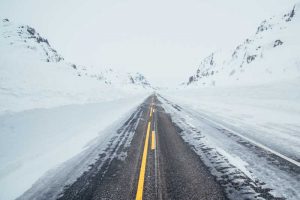
By Tiffany Coppock
“As engineers, we always have options,” says Billy Connor, director of the Arctic Infrastructure Development Center at the University of Alaska. Connor explains the job of the engineer is to specify the best material option in terms of cost, durability, and performance, as well as the owner or client’s desire. His research demonstrates another aspect of the engineer’s work—patience.
Since the mid-1980s, Connor and his colleagues have studied the performance of foam insulations installed in Alaska’s harsh permafrost terrain.
As the research continues to yield insights on how extruded polystyrene insulation (XPS) and expanded polystyrene insulation (EPS) tolerate moisture and retain thermal performance, it also poses new questions about the behavior of liquid and vapor moisture in soil.
Research conducted by Connor and researcher colleagues at the University of Alaska sought to expand the understanding of how both rigid foam insulations (XPS and EPS) perform over time when confronted by harsh conditions in below-grade applications. The most recent study, conducted in 2019, built on previous findings from research done in Alaska and Canada, examines the use of insulation in roadway embankments and airport runways.
In the study, insulation samples recovered from below-ground locations were examined for water absorption, water retention, and R-value maintenance. Project focal points included collecting new samples to expand on relevant data and reexamining the current data in light of new information. An additional goal was to develop a strategy for planning how best to incorporate insulation into roadside and airport projects based on an understanding of material performance.
Data gathered suggested thicker layers of EPS were needed to match the performance of XPS insulation in these situations. Researchers proposed several calculation options to determine the necessary thicknesses.
Insulating roadbeds and runways
Permafrost is the sub-surface layer of soil and rock where the temperature remains continuously below 0 C (32 F) for a minimum of two years and as many as hundreds of thousands of years. In Alaska, permafrost is found below about 85 percent of the state, according to the National Resources Defense Council (NRDC). Permafrost also is widespread in Canada and throughout the Northern Hemisphere.1 However, rising global temperatures have been increasing permafrost thaw, heightening interest on how to protect permafrost regions most effectively. Reports estimate 6.4 million km2 (2.5 million mi2) of permafrost may thaw by the end of the century.2
One concern is, when permafrost soils thaw, additional levels of previously trapped greenhouse gases will be released, further increasing the rate of climate change. Damage to buildings, roads, and paved areas is another side effect of thawing permafrost layers.
As the ground warms, previously solid areas can shift, causing roads and structures to warp and crack. In Canada, for example, about 3000 to 4000 km (1800 to 2500 mi) of road run over permafrost and roughly half of the paved area is in danger of becoming unstable from thawing ground.3 Much of the worst damage has occurred on a type of permafrost already susceptible to thawing, as it has a high ice content mixed with silty soils. This type of thaw-unstable permafrost is most likely to see damage from infrastructure work, according to the Alaska Department of Transportation. This type of permafrost is also found under parts of main arterial highways and critical rural airports across Alaska.4




